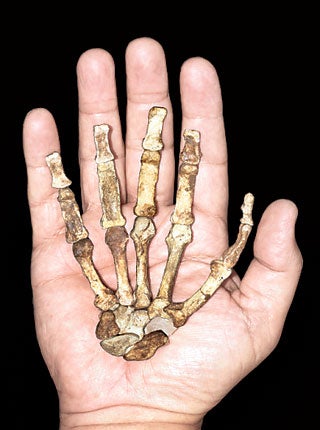South African 'apeman' could be a missing link, say scientists

A primitive species of "apeman" who lived about 2m years ago has become the strongest candidate for being the oldest direct ancestor of the entire family of human species, from the earliest Homo erectus to the anatomically modern Homo sapiens of today.
Click HERE to view graphic (131k jpg)
Exhaustive investigations of two partial skeletons of the primitive hominin – a young adult female and a male child of about 11 – have revealed that this extinct species possessed anatomical features unique to the human lineage.
Studies of the hominin's fossilised brain case, pelvis, hand and feet indicate that Australopithecus sediba, which was only formally identified 18 months ago, could turn out to be a crucial "missing link" that connects the human genus to the rest of the primate evolutionary tree.
Professor Lee Berger of the Univerity of Witwatersand in Johannesburg, who discovered the fossils at the site of an ancient cave system at Malapa, 30 miles north-west of the South African city, said the analysis provides convincing evidence that A. sediba was the immediate direct ancestor of the human species.
"The fossils demonstrate a surprisingy advanced but small brain, a very evolved hand with a long thumb like a human, a very modern pelvis, but a foot and ankle shape never seen in any hominin species that combines features of both apes and humans in one anatomical package," Professor Berger said.
"The many very advanced features found in the brain and body, and the earlier date make it possibly the best candidate ancestor for our genus, the genus Homo, more so than previous discoveries," he added.
Dating of rock sediments stuck to the fossils have placed the age of the skeletons to between 1.977m and 1.98m years – one of the most accurate dating estimates for this period in hominin history. This in itself puts A. sediba in a prime position for being the ancestor of Homo, which emerged as a distinct genus relatively soon afterwards.
The earliest accepted member of the the human family tree is Homo erectus, a species that lived between about 1.8m and 1.3m years ago, left Africa and became widely dispersed in Asia.
Earlier human species that lived in Africa, such as Homo habilis and Homo rudolfensis, which were dated to 1.9m years ago, were considered ancestral to H. erectus, but some experts have questioned whether they are truly human.
However, five different studies of A. sediba, which were published in the journal Science, indicate that it was in fact more human-like in much of its anatomy than H. habilis, the "handy man" who was thought to one of the first tool makers.
"The hand is one of the very special features of the human lineage, as it's very different from the hand of apes," said Tracy Kivell of the Max Planck Institute for Evolutionary Biology in Leipzig, Germany, one of many scientists who worked on the sediba analysis.
"Apes have long fingers for grasping branches or for use in locomation, and thus relatively short thumbs that make it very difficult for them to grasp like a human.
"A. sediba has, in contrast, a more human-like hand that has shortened fingers and a very long thumb," Dr Kivell said.
"Although at the same time, it appears to have possessed very powerful muscles for grasping.
"Our team interpreted this as a hand capable of tool manufacture and use, but still in use for climbing and certainly capable of human-like precision grip," she said.
Join our commenting forum
Join thought-provoking conversations, follow other Independent readers and see their replies
Comments
Bookmark popover
Removed from bookmarks